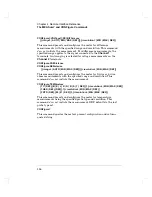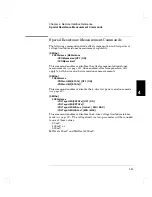
Selecting the Input Channel
The correct input channel is automatically selected for resistance and
temperature measurement functions. For voltage measurements, you
must select the input channel.
The easiest, but least flexible, method to specify the input channel is by
using the channel parameter in the
MEASure?
or
CONFigure
commands.
For example,
CONFigure:VOLTage:DC MAX, MAX, (@FRONt1)
Channel 1
CONFigure:VOLTage:DC MAX, MAX, (@FRONt2)
Channel 2
In the
SENSe
subsystem, the keyword is modified to select the input
channel. For example,
SENSe1:VOLTage:RANGe 10
Channel 1 range setting
SENSe2:VOLTage:RANGe 10
Channel 2 range setting
For increased flexibility, and to take advantage of the independant null
and range settings for each input channel, you can set each input channel
as desired and switch between the input channels using the
ROUTe:TERMinals
command. For example,
SENSe1:VOLTage:RANGe 10
Channel 1 range 10 V
SENSe2:VOLTage:RANGe .1
Channel 2 range 100 mV
ROUTe:TERMinals FRONt1
Select channel 1
READ?
Channel 1 measurement
ROUTe:TERMinals FRONt2
Select channel 2
READ?
Channel 2 measurement
You can determine which input channel is active with the query:
ROUTe:TERMinals?
The query returns either
FRON1
or
FRON2
.
Chapter 4 Remote Interface Reference
Selecting the Input Channel
140
Summary of Contents for 34420A
Page 1: ......
Page 2: ......
Page 13: ...1 Quick Start ...
Page 31: ...2 Front Panel Operation ...
Page 55: ...3 Features and Functions ...
Page 117: ...4 Remote Interface Reference ...
Page 200: ...5 Error Messages ...
Page 213: ...6 Application Programs ...
Page 245: ...6 Chapter 6 Application Programs Microsoft Excel Macro Example 245 ...
Page 246: ...Chapter 6 Application Programs Microsoft Excel Macro Example 246 ...
Page 247: ...7 Measurement Tutorial ...
Page 274: ...8 Specifications ...
Page 279: ...Dimensions Chapter 8 Specifications 34420A Nano Volt Micro Ohm Meter 280 ...
Page 294: ......
















































